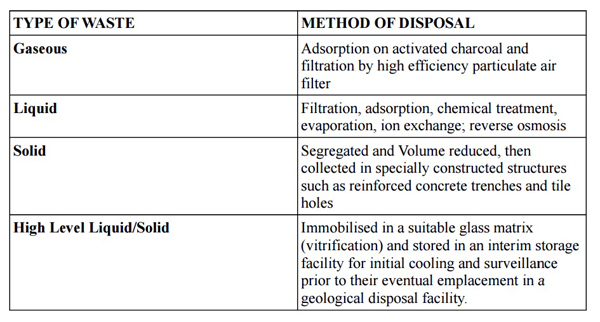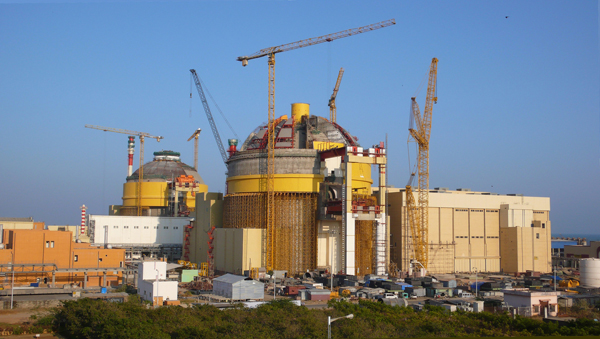 Kudankulam Nuclear Power Plant in the Tirunelveli district of the southern Indian state of Tamil Nadu.
Kudankulam Nuclear Power Plant in the Tirunelveli district of the southern Indian state of Tamil Nadu.
India and Canada have agreed to a $350 million nuclear fuel supply deal. This resumption, after 41 years, will be a milestone in boosting our nuclear energy production.
When did India begin its nuclear energy programme?
India's pursuit of nuclear energy began with the establishment of the Atomic Energy Commission in 1948 and the Department of Atomic Energy in 1954. Dr. Homi Jehangir Bhabha was the founder of India’s atomic energy programme.
India was one of the few countries to achieve the complete fuel cycle, from uranium exploration, mining, fuel fabrication, electricity generation and waste management by the 1970's. India's first nuclear reactor was built with Canadian and US assistance in 1952 and is located at the Bhabha Atomic Research Centre in Trombay. Called the CIRUS (Canadian-Indian Reactor US), it achieved criticality (the point at which its reaction is stable and can be used to generate power) in 1960.
Nuclear energy currently contributes a paltry 3.5% of India's total power generation, a far cry from a country like France, which gets almost three fourths of its energy from this source:

How many nuclear reactors does India have and where are these reactors located?
The current nuclear power capacity in India stands at 5780MW, from 21 reactors. Of these, the 100 MW RAPS 1 reactor is currently shut down for maintenance, bringing the total current output from nuclear power to 5680MW.
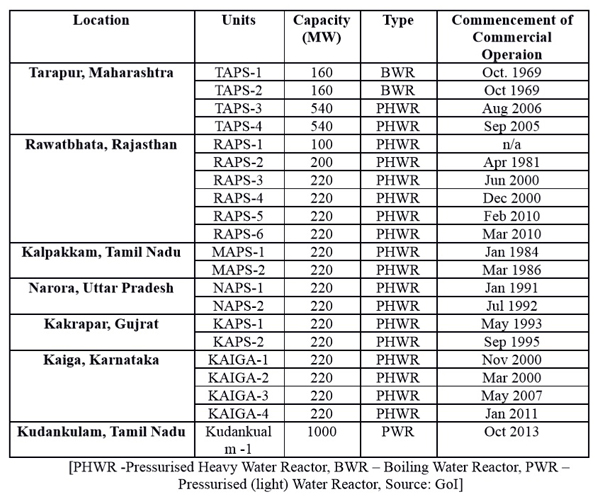
What are the new reactors that the government has planned to install?
There are a number of reactors under various stages of completion across the country:

There are also proposals for 19 new reactors under the XII five year plan:
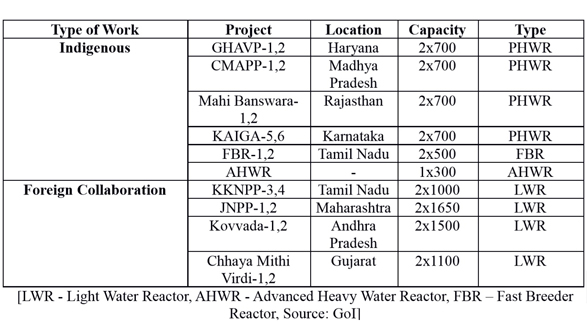
What does the Indo-US nuclear deal entail?
The 123 Agreement signed between the United States of America and the India is known as the U.S.-India Civil Nuclear Cooperation. The framework for this agreement was agreed upon in the joint statement by Indian Prime Minister Manmohan Singh and U.S. President George W. Bush. It is called the 123 deal, as it was negotiated, keeping in mind the stringent requirements of Section 123 of the US Atomic Energy Act 1954.
Following the nuclear weapons tests conducted under Prime Minister Indira Gandhi in 1974, India faced severe trade restrictions on nuclear technology. The 123 agreement ended that nuclear isolation and helped India diversify its nuclear trade partners. India also secured the rights to re-process the spent fuel procured as part of this deal.
Which countries currently provide India with nuclear fuel?
India has so far managed to receive fuel supplies from Kazakhstan, Uzbekistan, France and Russia. With the logjam in the Indo-US nuclear deal cleared, it is likely that we may be able to receive supplies from the US as well. On his visit to Canada, Indian Prime Minister Narendra Modi secured a $350 million deal with Canada to procure 3220 Metric Tonnes (MT) of uranium fuel for five years. This deal will go along way in augmenting India's nuclear power generation.
As per official data available, the following table depicts India's nuclear fuel imports over the last three years:
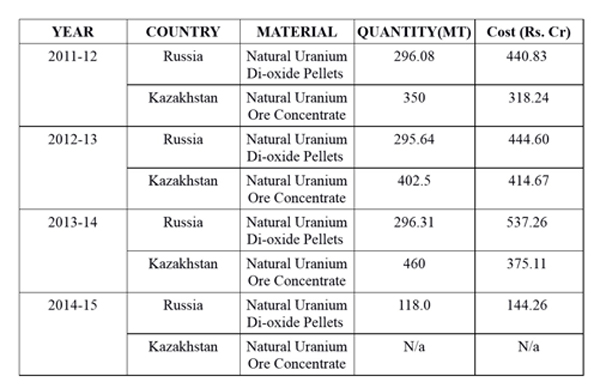
What are India's indigenous Uranium resources?
The Atomic Minerals Directorate for Exploration and Research (AMD), under the Department of Atomic Energy has established the presence of 1,71,672 tonnes of Uranium across India as follows:
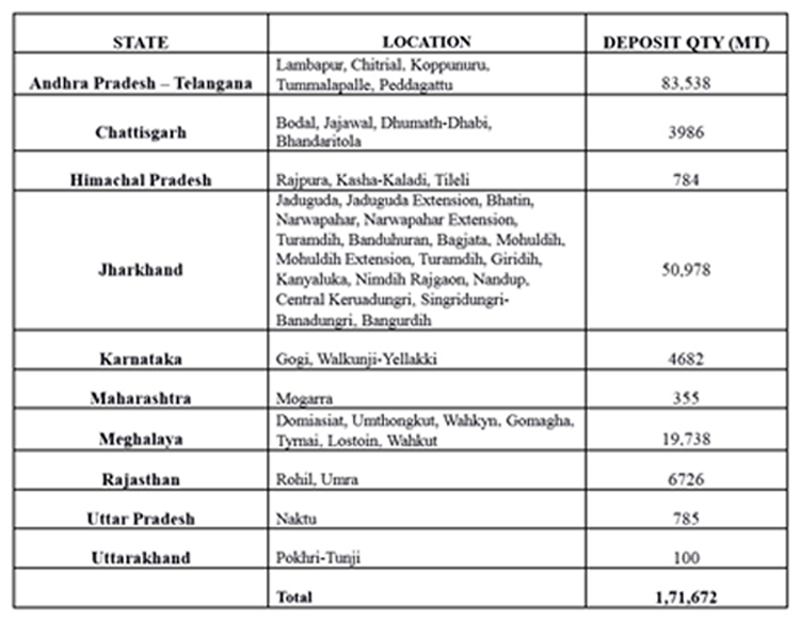
What is India's 3-Stage nuclear power programme?
India's 3 Stage nuclear power programme was envisioned by Dr Homi Bhabha, in order to ensure self sufficiency in producing nuclear energy in the long term. All current nuclear energy generation across the world relies on Uranium as fuel. Dr Bhabha envisaged the use of Thorium, another nuclear material as an alternative to Uranium..
India has one of the world's largest reserves of Thorium. It is not fissile (cannot undergo nuclear fission) in its natural state but when used in a reactor, it can be converted to become fissile.
In the first stage, India will use natural uranium to generate power, and extract the by-product, plutonium.
The plutonium is then used in the second stage to convert Thorium to a highly fissile version of Uranium called U233, while also generating electricity. More plutonium is produced as by-product in this stage, which will be recycled and re used. U233 is much more efficient than natural uranium and will be the primary fuel for the third stage of power generation. In this stage, the reactor will generate more fuel than it burns. Hence they are called U233 breeder reactors.
![[Dep U- Depleted Uranium, Pu – Plutonium, U233 – Uranium 233, Th – Thorium]](https://www.boomlive.in/wp-content/uploads/2015/04/Diagram.jpg) [Dep U- Depleted Uranium, Pu – Plutonium, U233 – Uranium 233, Th – Thorium]
[Dep U- Depleted Uranium, Pu – Plutonium, U233 – Uranium 233, Th – Thorium]
What are the common arguments against nuclear energy?
Several issues are cited for the world to abandon the quest for nuclear energy including costs, safety and environmental damage from waste. The biggest barriers facing positive public opinion on nuclear energy are safety and waste disposal.
1. Safety:
The world has witnessed three major catastrophes related to nuclear energy. These are the Three Mile Island incident of 1979, the Chernobyl disaster of 1986 and the Fukushima disaster of 2011. All these incidents involved the leakage of highly toxic radioactive substances into the environment which had major human and environmental consequences.
IAEA safeguards and safety standards work toward reducing the likelihood of such incidents recurring.
2. Waste disposal:
The average amount of nuclear waste generated across the world continues to increase annually. High level nuclear waste have half-lives (time taken for half the quantity of waste to become non-radioactive) of few thousand to few million years and is incredibly detrimental to the environment.
India's closed fuel cycle and thorium based reactor designs go a long way in reducing the quantum of waste. The closed fuel cycle ensures recycling of wastes and reduction in waste quantity. The half life of thorium based waste products (~50 years) is negligible compared to that generated by uranium (~1000-10,00,000 years) and hence can be managed more easily. Thorium by-products are not compatible for weapons use and hence reduces the risk of proliferation.
However for India to be able to harness energy from Thorium, it is essential that the first two stages of our three stage nuclear power programme operate at optimum efficiency. This is why India needs more Uranium for its reactors. Hence a robust waste disposal policy is essential to India’s nuclear energy programme.
What are the Indian Government's policies regarding nuclear waste?
The Indian government has waste disposal policies for nuclear waste arising out of all nuclear activity including medicine, industry, research and power generation. These policies have been in place since the inception of India's nuclear programme.
General fuel cycle techniques used in countries like the United States and UK is the open fuel cycle. In this, the fuel is used in once-through mode and all the waste generated is extracted, isolated based on their radioactive half-lives and are sent away for disposal. Thus the quantity of waste generated is very large and makes handling and disposal of such waste a cumbersome and exhaustive task.
India and France on the other hand use what is referred to as the closed fuel cycle, recycling the waste generated at the end of each cycle. Thus, the quantity of waste generated is considerably lower. However, unusable toxic high level waste is also generated through every stage which would require separation and geological isolation. About 640 tons of spent fuel was generated in the year 2012-13 from nuclear power generation in India. The waste generated is in liquid form and needs to solidified before being sent for geological isolation.
